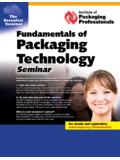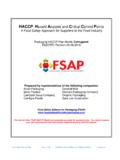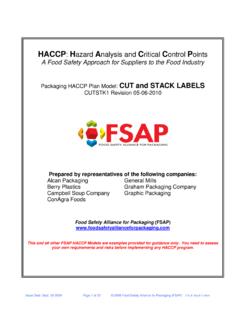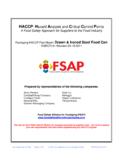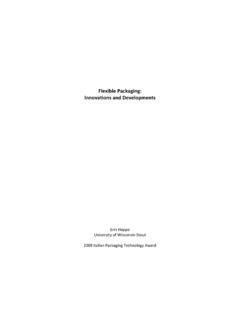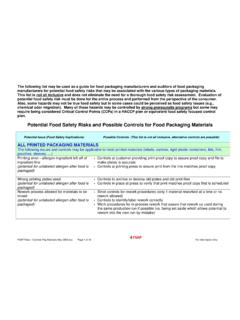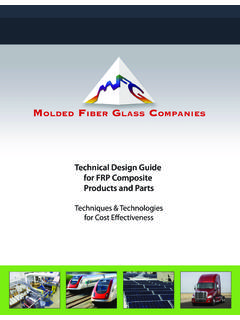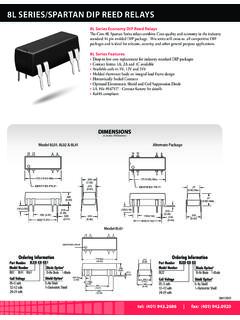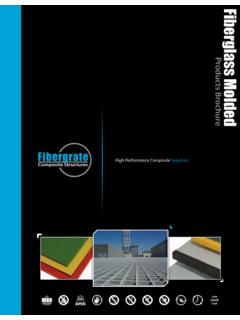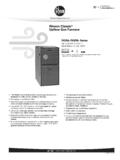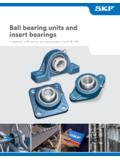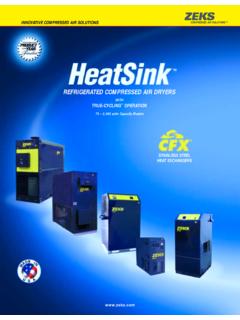Transcription of The reinvention of Molded Pulp - IoPP
1 1 The Re-invention of Molded pulp By Emily Howe Rochester Institute of Technology Molded pulp is no longer just a resource for packaging dunnage and egg cartons. It is quickly becoming a popular primary and secondary package due to its sustainable qualities. The manufacturing of Molded pulp is improving, making it easier for companies to design more developed Molded pulp packages. Companies are also taking the sustainability aspect of the material into account when designing their packages. Molded pulp can be made completely from scrap or recycled material (Twede and Selke, page 276, [14]).
2 It can also later be recycled with normal paper recycling or disposed of in other creative ways such as planting. History of Molded pulp Molded pulp is made from fiber slurry similar to that in the paper making industry (Twede and Selke, page 275, [14]). According to Wever and Twede [13], the first US Patent for a Fiber pulp Mold was created in 1903. It became a popular packaging mechanism and was improved upon quickly. Within a year of the first patent, another patent improving the machinery to produce Molded pulp was written. Keyes wrote both the first and second patents ( Keyes [5,6]).
3 The original Molded pulp machine is described in the patent as having a porous mold that is dipped in the pulp slurry. That mold is then compressed into a sister mold, also with pores, so that the excess slurry and liquid will drain out of the molds. The invention uses suction to help coat the mold with slurry and uses 2 compressed air to help release the Molded part after it has been formed between the two halves. The Molded part is then put in an oven to be dried ( Keyes [5]). As Twede and Wever [13] describe in their paper, History of Molded Fiber Packaging, Molded pulp was originally used with paperboard to make a fully functional package.
4 Soon users would manipulate the process and designs to make packages that are made entirely out of Molded pulp . Eggs were packaged in Molded pulp early on. The packages were designed for eggs, in addition to other products (Twede and Wever, page 3 [14]). Users began to design multi-functional packages for similar round products, such as fruit or light bulbs. The patents for this multi-use package dates back to 1920 (Twede and Wever, page 3 [14]). These package systems could also be made from a paperboard and Molded pulp combination.
5 Currently there are four categories of Molded pulp , but it was not always that way. Originally they separated Molded pulp into two categories, Plain Molded and Precision Molded (Twede and Selke, page 275, [14]). Plain Molded is similar to the original process where the mold picks up the fiber and removes the water. The Molded pulp is then dried in an oven. It will have one very rough side and one smoother side, where the slurry touched the mold. It is an economical and fast way of producing Molded pulp . In Precision Molding a second mold is utilized during the drying process (Twede and Selke, page 275, [14]).
6 This condenses the fiber and creates a more precise Molded part. Also the second mold allows both sides of the product to be smooth making it have a more attractive appearance. 3 About Molded pulp Currently there are four different types of Molded pulp based on the manufacturing process and quality of materials put into the process ( , [4]). The first is called Thick Walled referring to the usual 3/16 to 3/8 inch thick walls ( , [4]). It is made primarily out of scrap and Kraft paper (Twede and Selke, page 276, [14]). Due to its unfinished surface and thick profile this type of Molded pulp is used in packaging primarily for holding objects in place during shipping.
7 The process for making this type of Molded pulp is similar to plain molding as discussed in the previous section. The second type of Molded pulp is slightly thinner ranging from 1/8 to 3/16 inch thick ( , [4]). It is called Transfer Molding and is similar to Precision Molding. Both sides are finished as the pulp is transferred from one mold to another. This is why it is called Transfer Mold. Egg cartons are an example of this type of Molded pulp ( , [4]). The third type is called Thermoformed Fiber, where heated molds are utilized.
8 These molds make the product more precise in shape and the material denser. The heated molds also make it unnecessary to have a drying step (Twede and Selke, page 276, [14]). This Molded pulp is the closest in appearance to plastic once finished ( , [4]). It can be used in packaging applications and for such products as Molded plastic tableware ( , [4]). This is also the newest Molded pulp process (Twede and Selke, page 276, [14]). 4 The final type is called Processed pulp and takes one of the other three types of Molded pulp and finishes it.
9 This could be adding printing, additives, coatings and items such as seeds, which will be discussed later ( , [4]). This would be considered a Type 4 Processed pulp package ( , [4]). Molded pulp has similar properties to expanded polystyrene and is therefore a good cushioning material ( , [10]). The cushion curves from Pacific pulp , shown in Figure 1, compare the performance of expanded polystyrene to Molded pulp . It measures how much acceleration, in G s, the cushion is able to absorb over a range of static loadings. The Molded pulp was actually a better protective cushion then the expanded polystyrene.
10 The performance shown on a cushion curve is dependent upon the manufacturer of the material and the thickness, size and shape of the cushion. This not only helps in Figure One: Cushion Curves [10] Figure Two: Drop Test [10] 5 dunnage, but also helps when using Molded pulp as a primary or secondary package, since it has strong protective qualities. If your package is exposed to shock, then the Molded pulp package will be capable of absorbing that shock and the product would be protected. The drop test shock pulses shown in Figure 2 illustrate the shock, or acceleration, in G s, experienced during impact ( , [10]).
